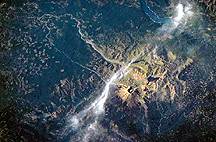



|
Volcanic Hazards
Active volcanoes pose many hazards to life and property. Some hazards, like huge lava flows
and explosive blasts associated with volcanic eruptions, are spectacular headline grabbers
and recognized by everyone. Others, like glowing avalanches and ash falls, are much less
flamboyant and less known by the general public, but they can be just as deadly. A few
hazards, such as rockslides and mudflows, can occur even in the absence of an eruption.
Short descriptions of many volcanic hazards are given here. If you wish more information
on volcanic hazards, click here.
 Lava
flows are sheets and tongues of liquid rock expelled from the crown or flank of an effusively
erupting volcano and are probably the best known volcanic hazard. They are usually
depicted in books and movies as roaring down the erupting volcano's steep slopes to
inundate houses, cars, trees, and expendable movie extras. Although some lava flows can
travel at 50-60 mph, others move at human walking speeds or slower. The speed of a flow
depends on the viscosity of the lava and the incline of the volcanoe's slope. The
destructive power of lava flows lies in the high temperature of the rock, which can set
structures aflame, and in the size and mass of the flow, which can engulf or crush even
large buildings. Some lava flows are small enough for a person to step across and cause
little damage; on the other hand, lava flows like the Columbia River Basalts are
large enough to cover entire states and destroy everything in their
path. Photo: Courtesy of
NGDC/NOAA. Lava
flows are sheets and tongues of liquid rock expelled from the crown or flank of an effusively
erupting volcano and are probably the best known volcanic hazard. They are usually
depicted in books and movies as roaring down the erupting volcano's steep slopes to
inundate houses, cars, trees, and expendable movie extras. Although some lava flows can
travel at 50-60 mph, others move at human walking speeds or slower. The speed of a flow
depends on the viscosity of the lava and the incline of the volcanoe's slope. The
destructive power of lava flows lies in the high temperature of the rock, which can set
structures aflame, and in the size and mass of the flow, which can engulf or crush even
large buildings. Some lava flows are small enough for a person to step across and cause
little damage; on the other hand, lava flows like the Columbia River Basalts are
large enough to cover entire states and destroy everything in their
path. Photo: Courtesy of
NGDC/NOAA.
 The
explosive
blast is the "feature presentation" of a (surprise!)
explosively erupting volcano. It is an outburst of fragments of rock and lava driven by
expanding gases that were dissolved in the erupting lava at great depths. These blasts
may throw great blocks of rock many miles. However, the superheated blast cloud itself,
which expands out from the volcano at hundreds of miles per hour, enveloping and searing
anything in its path, is more destructive. The destructive power of the blasts lies in the
high velocity winds (exceeding wind speeds in hurricanes) within the cloud and the very
high temperatures of the gas. The blasts are capable of destroying all life within many
miles of the volcano in a matter of minutes. The main blast at Mount
St. Helens destroyed more than 230 square miles of forest in a few seconds. The
destroyed area is pictured to the upper right of the shattered cone of the mountain in
this shuttle image. Photo: NASA
shuttle photograph #STS 47-73-056 (EarthRISE archive). The
explosive
blast is the "feature presentation" of a (surprise!)
explosively erupting volcano. It is an outburst of fragments of rock and lava driven by
expanding gases that were dissolved in the erupting lava at great depths. These blasts
may throw great blocks of rock many miles. However, the superheated blast cloud itself,
which expands out from the volcano at hundreds of miles per hour, enveloping and searing
anything in its path, is more destructive. The destructive power of the blasts lies in the
high velocity winds (exceeding wind speeds in hurricanes) within the cloud and the very
high temperatures of the gas. The blasts are capable of destroying all life within many
miles of the volcano in a matter of minutes. The main blast at Mount
St. Helens destroyed more than 230 square miles of forest in a few seconds. The
destroyed area is pictured to the upper right of the shattered cone of the mountain in
this shuttle image. Photo: NASA
shuttle photograph #STS 47-73-056 (EarthRISE archive).
[ Volcanoes & Climate ] [ Monitoring Volcanoes ]
[ Volcanic Hazards: page 1 / page 2 / page 3 / page 4 ]
[ Dealing with Volcanic Threats ]
[
References ] [
PBL Model ]
[ Home
] [ Teacher
Pages ] [
Modules &
Activities ] |



